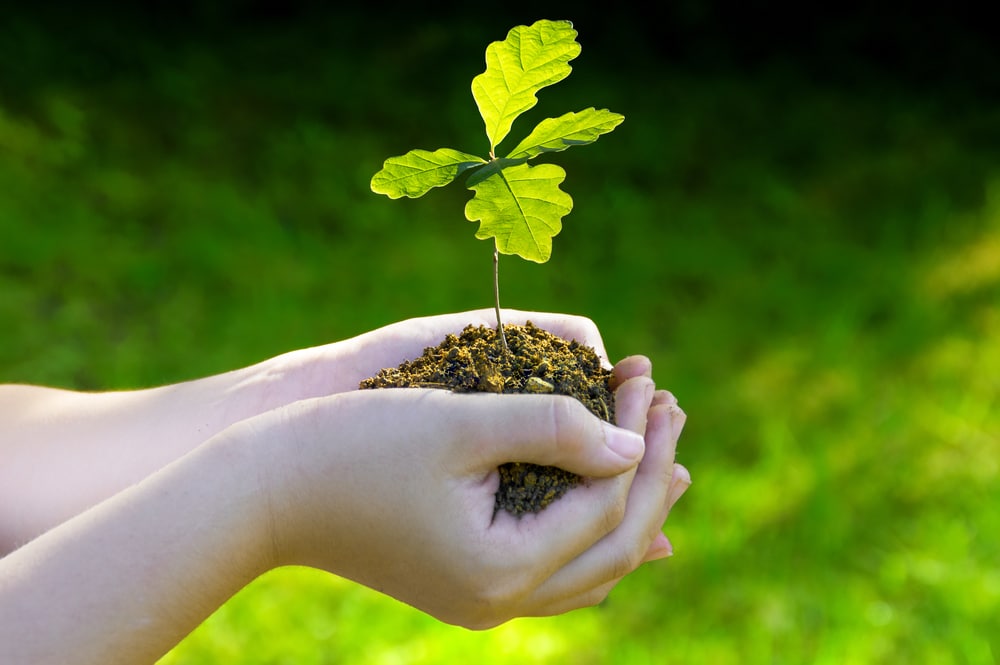Oak trees are one of the oldest and most recognizable of North America’s hardwood species. Their valuable wood is used in furniture and construction, while their deep shade provides welcome relief on hot days.
Fortunately, it is easy to start your journey to grow a mighty oak by transplanting an oak sapling—provided you follow the simple steps described below.
Transplanting Oak Saplings
Transplanting oak saplings is a great way to help improve your local environment and beautify any space. To successfully do so with minimal effort and expense, you must choose your sapling, prepare the area it will go in, and transplant it in a way that encourages growth.
1. Choose the Time
The first step is to choose the right time of the year.
The best time to transplant oak saplings depends on the season, soil conditions, and other factors. As a rule, it is best to do so in the late fall or early spring, when the tree is dormant. This will minimize stress on the tree and give it the best chance of survival.
2. Choose Your Sapling
When you choose your saplings, the first thing to keep in mind is that not all oak trees are equal. Research native species of oak trees in your area to ensure the sapling is best suited for your growing conditions. This will significantly increase its chances of successful growth and establishment.
With the desired species in mind, start with young, healthy saplings grown in an area with similar environmental conditions to transplant them. Select saplings that are healthy and free from pests and diseases. Look for signs of stress or disease and make sure all leaves and branches are healthy and strong. Choose larger saplings with more established root systems and higher growth potential.
3. Prepare the Space
When transplanting an oak sapling, the best space to choose is one with plenty of sunshine. Pick an area that gets at least six hours of direct sunlight.
Soil is just as important. Avoid areas with compacted soil or standing water, and make sure the soil doesn’t become waterlogged by regular rain or irrigation. Check for drainage problems by digging a hole and seeing how fast it drains after filling it with water. pH levels range between 6.0 and 7.0.
Additionally, make sure that nothing is growing underneath the tree that could compete with your sapling for nutrients in its early stages of growth. Evaluate nearby plants such as grass or weeds and ensure that your oak sapling has no competition from other mature trees or shrubs that could choke out its growth.
Finally, choose a place with plenty of open space for the sapling’s roots to spread wide.
Once you have picked the right spot for your oak sapling, prepare the soil with ample organic matter like compost or mulch before planting to promote the best possible health conditions. Before transplanting, thoroughly water the sapling to loosen the soil around the roots. Dig a hole that is wider and deeper than the root ball and mix it in compost or other organic matter to improve soil quality.
4. Moving the Sapling
Transplanting an oak sapling requires some care and attention, as you want to make sure the roots remain intact and undamaged. The first step is to carefully dig up the sapling with a garden spade or shovel, keeping the root ball intact and not damaging the root system. Place it in a bucket with some damp soil for transport if needed.
Dig a hole slightly larger than the associated root ball. This will allow space for backfill and promote new root growth into surrounding soils. Be careful not to overdo it, though—digging a wide hole rather than a deep one is better. As a rule of thumb, the planting hole can be as deep as the sapling’s root ball and twice as wide.
Next, backfill the hole with nutrient-rich soil and use your hands to press gently around the root system, thus removing any air pockets. Oak saplings have fragile root systems, so handle them carefully to avoid damage.
5. Encourage Growth
Once you have safely transplanted your sapling, water it regularly to keep the soil moist—but not soggy—during establishment periods. You should generally water a couple of inches per week or as needed if there is no rain. Don’t overwater, as this can lead to root rot and other diseases. The establishment period takes approximately three weeks. During this time, monitor its growth for signs of stress or disease.
It may help to add a layer of mulch around the tree’s base to retain moisture. Besides suppressing weeds, this can help protect against extreme temperatures, drought conditions, and disease in the area around your tree’s roots.
Fertilize your oak sapling throughout its first year and use pruning tools or stakes as necessary for proper branch structure maintenance. Protect the tree from excessive wind or cold temperatures if needed, especially when young.
Monitor for pest activity and take action if necessary, using organic methods whenever possible. An organic pest control method may help prevent potential pests or diseases that could harm your growing tree.
Possible Issues with Oak Sapling Transplantation
The above tips should help ensure the successful transplant of your oak sapling. However, things can always go wrong, from inadequate growth space to over-fertilizing. Here are some common mistakes and how to fix them.
Inadequate Space for Growth
If your transplanted oak sapling has inadequate space for growth, it may be stunted in its development and fail to reach its full potential. Without adequate space, the roots may not receive the nutrients they need to grow and thrive, and the tree will not have enough room to spread and maximize photosynthesis.
Your tree may also need help accessing sufficient water resources if surrounding plants compete for the same resources or if the soil is too dry. Without enough space, your tree could also become vulnerable to insects, disease, harsh weather conditions, and other external factors that can damage its health or even kill it.
In order to give your tree the best chance of reaching its full size and living a long, healthy life you should provide it with adequate space for growth right away.
Incorrect Size Hole
A hole that is too large or too small can cause damage to the tree root system. A small hole will limit the amount of oxygen and nutrients the roots can receive, while a large one can lead to root rot and other problems.
One common mistake is to dig deeper than you need to. You may think you can just backfill the hole if this happens. Unfortunately, the soil under the roots can compact and sink the tree deeper into the danger zone. Try to dig your hole no deeper than the root ball of your tree and make a wide hole rather than a deep one. This will ensure adequate oxygen flow and help keep your young oak tree healthy.
Poor Soil
Soil quality is paramount when it comes to successful transplanting. If you transplant an oak sapling to poor soil, its chances of surviving and thriving are significantly lower. Poor soil lacks the necessary nutrients for a healthy tree. This can lead to stunted growth, increased susceptibility to pests and diseases, and reduced yields of acorns. Additionally, insects and other pests are more likely to inhabit poor soils, making the sapling vulnerable to damage.
Ideally, you should plant your oak sapling in well-prepared soil already rich in organic matter. If this is not possible, give your oak sapling extra care with regard to watering, fertilization, and pest control. Providing adequate water and fertilizer can help the tree compensate for any deficiencies in the soil as well as encourage faster growth.
Over-Fertilization
Over-fertilization can cause the sapling to grow too quickly and become top-heavy. This can increase the risk of the plant being uprooted or damaged by strong winds.
Additionally, salt buildups can occur in the soil due to excessive fertilizer. This makes it difficult for water and nutrients to reach the roots of your sapling.
Finally, overfertilizing may also cause burning of the leaves, browning of foliage, stunted growth, and reduced flowering. Nutrient imbalances can even lead to death in young trees.
To avoid such risks, only fertilize when necessary and always follow manufacturer instructions.
Wrong Species for Location
Each region has its species that have evolved to match the specific characteristics of their environments and perfectly fit them. Choosing an oak species that is ill-suited for your climate region for can have several adverse effects. The sapling may fail to survive in the climate and die shortly after planting. The sapling may also struggle with seasonal changes, temperature differences, and precipitation fluctuations.
In addition, some species require specific soil types and nutrients. If these are unavailable in your region, you may end up with poorly established trees or saplings that struggle to grow and thrive.
Ultimately, selecting the wrong species could cost you time, money, and resources—with no results due to a lack of success in growing and supporting the tree through its life cycle. Selecting the right oak species for your region is thus crucial in ensuring a successful oak sapling transplant.
Unfortunately, you cannot do much once you have chosen the sapling. It is important to make an informed decision by researching which oak species are native to your region. Learn about important characteristics such as their growth rate, preferred soil type, climate needs, and insect resistance.
Also, ensure that your chosen species is suitable for local wildlife. If there are animals living in or near your area, consider selecting a species that provides food and nutrients.
Shop around for nurseries that specialize in selling oak trees. Ask each one about their experience with a particular species or variety to ensure it suits your location.
Finally, consider any local climate changes or weather patterns when selecting your specific oak tree. Certain species may be more resistant to extreme temperate changes than others in their genus.
If you live in Texas, you could choose from a wide selection of local oak species, such as the Southern Red Oak (Quercus falcata), Loblolly Oak (Quercus laurifolia), Water Oak (Quercus nigra), Post Oak (Quercus stellata), and Blackjack Oak (Quercus marilandica). Other common varieties of oaks found in Texas are the Shumard Oak, Live Oak, Chinquapin Oak, Overcup Oak, and White Oak.
What If I Must Transplant My Oak Tree Again?
A transplanted tree can be very sensitive in its new environment and need some time to adjust. This change will likely involve some transitional shock even after a successful relocation. If the transplant was done properly, though, the tree would soon acclimate at its new location.
What if you need to move it again, though?
Generally speaking, trees are most sensitive to moisture and temperature changes shortly after transplanting. Regular care is key in reducing stress on the tree and helping it become established in its new environment. The sensitivity of a transplanted tree will vary depending on many factors, such as the size and species of the tree, the transplant methods used, and the site conditions.
If you need to transplant a fully-grown oak tree, remember that the tree may be sensitive to the stress of moving. You should seek professional advice before carrying out any transplantation process.
For a fully grown oak tree, you must properly plan the move and work with an experienced arborist who can ensure the safety of the tree and its surrounding area during the move.
An arborist will have the experience and knowledge to properly transplant the tree to minimize the risk of damage or death. For example, you should properly examine the oak tree’s roots before attempting a transplant, as they may need to be pruned or mulched if they are too long or unwieldy.
The key to transplanting an oak tree that is already fully grown is to do it as quickly and gently as possible. To ensure a successful transplant, choose a new location with soil conditions as similar as possible to the current site.
When moving a mature oak tree, ensure the entire root ball is kept intact, and all soil is kept moist during the process. You may also need to provide extra support, such as staking and appropriate pruning. Once transplanted, monitor your tree closely for signs of stress or strain that could indicate it needs additional care. With patience and proper preparation, your mature oak tree should successfully transition and fully adjust to its new environment over time.
When In Doubt, Call The Experts
Although most people never think they will need to move their oak tree after planting a sapling, the reality is sometimes moving fully grown trees is a must. When you find yourself in a situation where you need to relocate a tree that is deeply rooted, don’t try to do it yourself. Call the experts at Environmental Design.
With over 40 years of professional experience, we’ve moved more than our fair share of large trees. We handle large tree transplantation, Arborlifting®, tree farming, and custom growth. If you’re looking for the best way to relocate your favorite oak tree, give us a call so we can help you explore your options and develop a customized plan to move your tree




Recent Comments